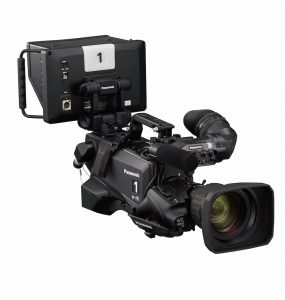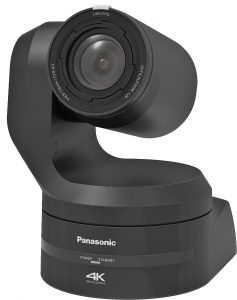SVG Europe Sit-Down: Panasonic’s Andre Meterian with thoughts on HDR, 8K and 12G

Andre Meterian, director of broadcast & ProAV EMEA, Panasonic
Panasonic provides a wide range of technology that can be integrated into a variety of broadcast and professional video environments. This includes the company’s VariCam line-up of digital cinematography cameras, cost-effective studio camera systems for 4K and HD live production, production switcher solutions and AVC-ULTRA and P2HD camcorders. Panasonic is also giving users more freedom to capture content through a comprehensive 4K remote camera solutions.
With a wide range of equipment on offer, our conversation with Andre Meterian, director of broadcast & ProAV EMEA, had the scope to cover a variety of topics…
Panasonic has had a busy year. What have been the highlights?
Aside from our extensive work with Mediapro, we have gained numerous prestigious customers, such as EuroMediaGroup, NEP, AV Set and CTV in Europe, and more recently we’ve expanded within Africa too. An example being CIP and MyProd in Algeria, where Panasonic is supplying 4K studio cameras.
Panasonic offers the best solution to meet the 4K challenge and is investing heavily in the development of studio cameras; this is a key market to reach our goal of leading the live market by 2020.
A great example is France Télévisions which is also set to install Panasonic UHD cameras in a two-year upgrade of its digital studios and OB vans throughout France. By the end of the project, the broadcaster will have taken delivery of more than 100 Panasonic AK-UC3000 studio cameras.
This is a big growth area for Panasonic. Last year we hit a major milestone, with a total 1,100 studio cameras sold in to the European market since their introduction only a few years ago. 730 of these were for the live market, which represents a gain of 16% in market share in only two years.
You recently partnered with IMT Vislink to offer ‘FocalPoint’ camera control compatibility. Can you tell us about the benefits this brings to users?
The partnership will see IMT Vislink’s external wireless solution integrated into the Panasonic studio camera range, enabling an end-to-end video capture, transmission and receiving workflow for various broadcast applications.
We think that our users will find that the joint development we have carried out will ensure that they have a smooth workflow for live wireless broadcast.
With the BBC streaming the World Cup in HDR, will this speed up the acceptance of this technology? And what are you offering in HDR?
We’ve responded to the requests of many customers and introduced HDR support across the studio camera and box camera line up in both Full HD and 4K. High Dynamic Range technology offers an enhanced experience thanks to highly contrasted pictures which look more alive than ever, it’s the next best thing to being at the game.
Our cameras can handle simultaneous SDR and HDR outputs, which has also been requested by the market.
In January, we also announced an upgrade to our VariCam range that sets the cinema camera up for live and ‘near live’ multi-cam use within concerts, events, TV shows and corporate productions.
Using a VariCam LT cinema camera offers several benefits over smaller sensor broadcast cameras that are typically used for live events including HDR. These include the ability to create cinematic depth of field with VariCam’s award-winning Super 35mm sensor, the advantage of the VariCam’s HDR-ready 14+ stops of dynamic range, the capability to capture low light shots using VariCam’s Dual Native 800/5000 ISO feature and the fact that the 5000 ISO compensates for any F drop due to a lens adapter or long zoom focal length
Looking further ahead, what are you planning in the area of 8K?
Panasonic has announced the development of an 8K – 36M pixels, 60fps framerate sensor. A global shutter functionality means imaging with sensitivity modulation function simultaneously, using a CMOS image sensor with an organic photoconductive film (OPF).
With the new technology, it is possible to capture images at 8K resolution, even in high contrast scenes, such as a field under strong sunlight and shaded spectator seats under a stadium roof. It also enables high picture quality imaging without motion distortion.
This new technology means switching between high sensitivity mode and high saturation mode is possible using the gain switching function.
Can you tell us about your thinking when it comes to 12G?

The AK-UC4000 is Panasonic’s latest 4K studio camera
12G is definitively a ‘must to have’ in our broadcast products. Even if the switch to IP workflows has started, SDI remains the standard, and 12G is the way to go to carry uncompressed 4K signals at the moment. So, our studio cameras and box cameras offer this feature in order to be easily integrated in current workflows. Of course, these 12G SDI outputs will be complemented very soon by Media over IP signals coming out of the same CCUs so that customers will be able to use them in any infrastructure.
What can we expect from Panasonic at IBC 2018?
At IBC we’ll be demonstrating our biggest live production space to date. We’ll create the studio space of the future where robotics, dolly and rail systems are integrated perfectly with our camera technology and switchers.
This approach stems from our success within remote cameras and we’ve set out to ensure that the integration of these systems is much easier for both sports and other live production areas. Ease of use is what pushes the demand for this form of production.
The highlight will be our new AW-UE150 integrated PTZ camera, which will offer, for the first time, very high quality 4K pictures in 50/60p, and some amazing new features like multiple video outputs with cropping to simulate different viewing angles, real-time positioning for Virtual Reality applications, RTMP streaming, and a brand new, super-flexible controller.
What are your biggest challenges over the next twelve months?

The UE150 is Panasonic’s latest PTZ camera and will be introduced at IBC2018
Panasonic has already expanded its 4K range with the introduction of the AK-UC4000, Panasonic’s latest 4K-studio camera system which is aimed at the production, rental and live-event operations. Over the coming year, however, our aim is to add more 4K products to our already established line up to ensure our clients are sufficiently futureproofing their systems.
Panasonic is also looking more into the introduction and development of its 8K sensor and incorporating it into Panasonic’s professional camera systems. Panasonic has targeted the 2020 Olympics as a test bed for delivering 8K content alongside host broadcaster NHK.
On a more global level, the biggest challenge for the industry at the moment is moving from traditional video to IP based production. The benefits are big of course, with products that are more flexible, scalable and powerful, however, this is a big step to take and it raises challenges on every level. Panasonic is committed to offering the best possible solutions to help customers with this major change of technology. We are actively working on this by developing new products, while doing our best to stay up to date with current trends and new standards that are emerging.
